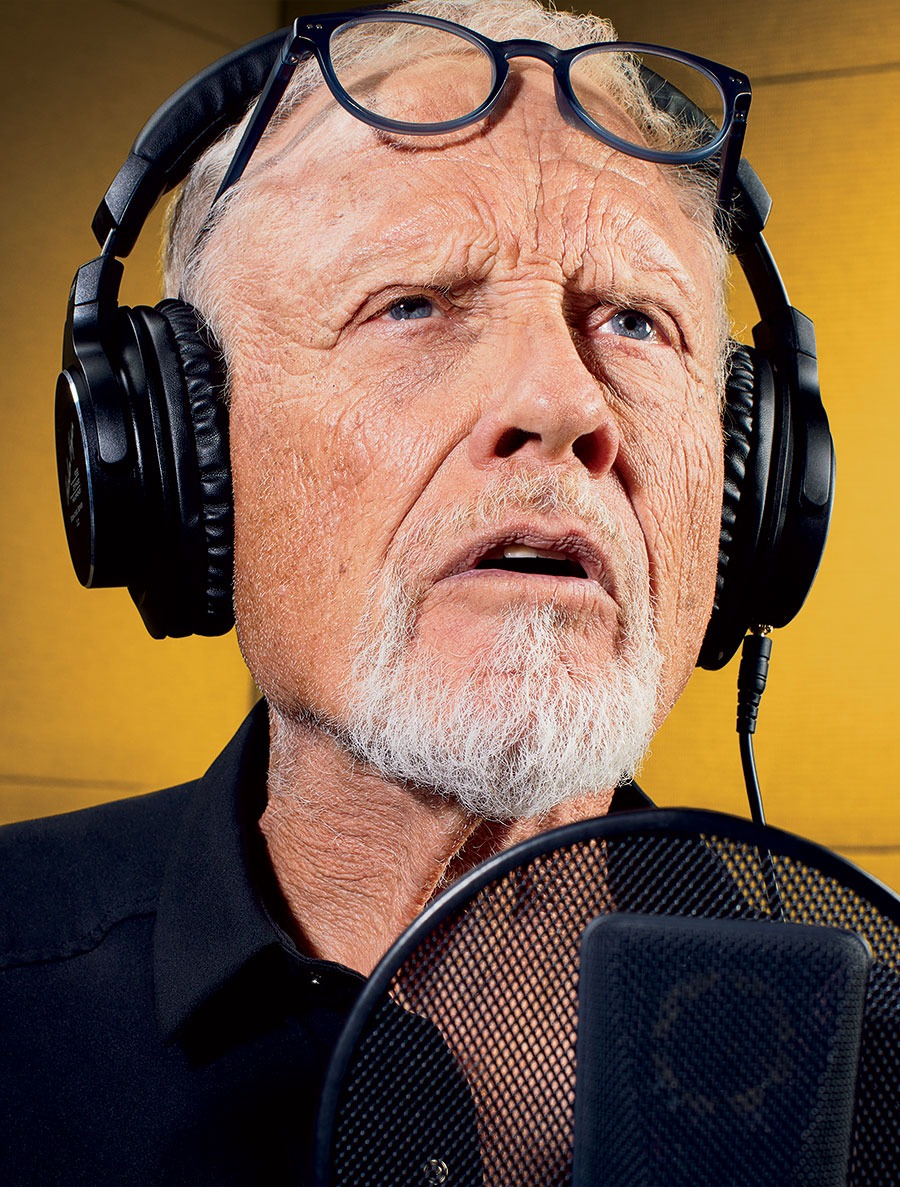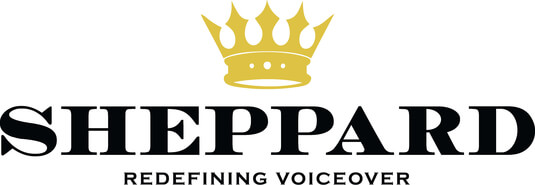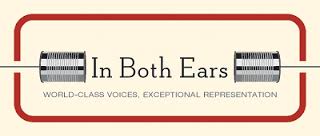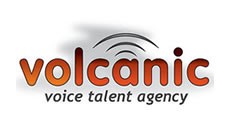Everyone Tells Me I Have a GREAT VOICE
by Tal Rosenberg
On the last day of the Acting Studio Chicago's Voice Acting class, we met over Zoom, and our instructor Brad Grusnick, a professional VO actor, gave us tips on our home setups and provided agency contacts and reference sites. He asked us if we had any more questions. I had one: "Was there a rock star of VO? Was there anyone in Chicago who was the king or queen of the biz?"
Grusnick thought for a bit and said that currently the playing field was pretty level, with no real standouts. I mean, there isn’t a Harlan Hogan or anything like that.”

Harlan Hogan
W hat’s the story about?” Harlan Hogan is speaking rhetorically, but he’s also telling me the most important question to ask yourself when you get a script. We’re standing a bit awkwardly in a WhisperRoom recording booth in his home office, almost as if I’m looming in the doorway of a high-tech port-a-potty. It’s roughly four by four by seven feet, and for the past quarter century, this closet-like compartment is where Hogan has worked.
Hogan, 76, has a shock of white hair, a closely cropped beard, and oceanic blue eyes. He’s lithe and agile for his age, padding around gracefully in wool slippers and zip-away hiking pants. His voice is the macho purr of commerce, a gently leonine growl that conveys ease and fatherly compassion. When he talks, you can hear shampoo, beer, cereal, health insurance, and super PACs. Hogan has read spots for all of them. One time, he voiced a dozen commercials in a single day. He’s unquestionably one of the most recognizable and successful Chicago voice actors in the medium’s history.
On this early July day, Hogan is reviewing voice-over narration he recorded for a short documentary honoring Milt Larsen, the recently deceased founder of the Magic Castle, a secretive and exclusive clubhouse for magicians in L.A. Hogan, obsessed with magic since childhood, has an elaborate showroom of thaumaturgical memorabilia in his basement, and his house is adorned by vintage magic posters. The short played during the Academy of Magical Arts’ annual awards show in Los Angeles. Hogan has been a member of the Magic Castle for 44 years, and producers comped his airfare and tickets to the black-tie event.
He brings up the job to demonstrate how he approaches his work. When he got the script, he started by invoking his first rule: Try to analyze the story. “I address these things as a play. So I read the first few things, and I said to the producer, ‘Yes, it’s a documentary with facts. But to me, it’s a love story.’ ” The producer enthusiastically agreed.
Hogan keeps three microphones in his booth, and for this narration he decided on a Sennheiser MKH 416 shotgun mic, which looks like a long black cigar. “They were originally designed for location recording,” he says. “If you’re a person who moves around, it’s not a good mic, but I use it a lot on things that are just a little edgier.” The 416 is particularly sensitive to noise, so Hogan demonstrates how he voiced the script gently, and with a slight gristle, exactly like someone reading a love letter out loud.
All this is happening in Hogan’s mansion in North Barrington, where he lives with his wife, Lesley, who used to be his agent. “My corny voice-over joke” — Hogan has many corny voice-over jokes — “I had to marry my agent because it’s the only way she’d return my calls.” The house is white clapboard, with a three-car garage and a long porch lined with pots of bright purple flowers. Hogan and his wife also own a sailboat and two horses, not to mention a motorcycle (he is a card-carrying member of the Iron Butt Association, signifying he once rode more than 1,000 miles in 24 hours).
Hogan’s home office is the size of a studio apartment, dotted with memorabilia like vintage microphones and a still-operational wire recorder from the 1940s. Next to his booth is a desktop computer, a mixing console, and speakers for him to hear playbacks of his recordings. After Hogan does his reads, he’ll do a light edit before sending it off to the engineer. He likes to do his takes in “trips,” offering three options.
As he plays me the version of the documentary voice-over that the producers selected, I notice a particular twist in one line. “The castle property is filled with skewed architectural pieces from all over the world,” Hogan intones, “including vintage stained glass, old wood paneling, and whatever Milt found interesting.” Hogan had added a pause between “whatever Milt” and “found interesting,” articulating a sly wink to Larsen’s eccentricities. I asked him how he came up with that, and he explained that sometimes you have to visualize what you’re saying and consider how to re-create that image in speech.
A native of south suburban Lansing, Hogan studied theater at Illinois Wesleyan University, then headed straight to Chicago, where he bounced around, working in radio (“It’s pretty much the same thing: ‘Time and temperature, cooler near the lake, we’ll be right back with Sonny and Cher’ ”) and dinner theater (“Peaches Pancake House and Dinner Theater; think of buying pancakes with The Odd Couple”) and as a salesman for Honeywell (“Of course we all know that a BFA in theater is just the training you need to sell computers”).
The Honeywell job is what led to Hogan’s first big break. In the mid-1970s, his agent set him up with an audition for the accounting giant Arthur Andersen, as a narrator for corporate training videos. “They hand me a bunch of pages, and it’s all about computers,” Hogan says. “So I’m reading a book on how to take care of your systems analyst. And I rambled on and on, and they said, ‘We’re flabbergasted! We’ve seen like 20 people today, and nobody knew how to pronounce all this stuff. I can tell you right now, we have a lot of videos for you to do.’ ” Hogan performed in more than 100. “Pure dumb luck. I was bringing in more money than when I was in sales.”
Hogan knew the Arthur Andersen gig wouldn’t last forever, so he got a part-time job as a disc jockey at WCLR, which at the time was an easy-listening station. He used the radio station to produce his demos and soon began finding lucrative opportunities in VO work. “I could do numerous commercials versus maybe one on-camera every six months if you’re lucky, and we all know theater doesn’t pay squat. One person who had been in the business told me, ‘Oh, Harlan, I don’t think you should do that, they’ll typecast you.’ Well, there’s two words there: ‘Type’ I don’t care about, but ‘casting’ sounds real good.”
Up until the late 1970s, advertisers wanted cartoonish voice acting, and there were Chicago performers who happily obliged, like Larry Moran, a.k.a. the Funny Voice Man, who played Cap’n Crunch, Mr. Monopoly, and McDonald’s Grimace. Or they sought people with unique deliveries, like James C. Dolan, who cofounded Streeterville Studios here and boasted a deep baritone that was ubiquitous on the airwaves. But advertising was entering a transitional period where the traditional disc jockey sound was losing favor to a more conversational style.
Hogan singles out Joel Cory, a retired Chicago VO luminary now living in Florida, as every agency’s first choice, a “vocal chameleon” who long played Pop from the famous Rice Krispies trio. In the ’80s, Hogan and Cory were part of a crew of legendary local voice actors, many still performing today, like Tim Dadabo, Jeff Lupetin, and Pete Stacker. In my conversations with voice actors, Stacker’s name came up often. When you hear his rumbling, looping bass voice, you can quickly place it in everything from Comedy Central promos and big Budweiser campaigns to the video game Halo and the Hot Tub Time Machine trailer. He is so closely correlated with “the movie trailer voice” that Saturday Night Live used him for a movie trailer parody in 2015.
In the ’80s, Hogan and other voice actors would hang out at the Boul-Mich Lounge, a burger and dive bar at Michigan and Grand Avenues in the Near North Side, because it had a direct line to Marietta’s Answering Service, where performers would get calls from talent and ad agencies. “You always wanted the bartender to say, ‘Hey, Harlan, it’s Service.’ ”
This was during what Hogan refers to as the “golden age” of VO in Chicago. In those days, advertisers had limited outlets: newspapers, magazines, billboards, radio, and broadcast TV. That meant they would shell out top dollar for this precious real estate. Voice actors got paid not only for their performance of a spot, but in residuals every time that spot played. If you landed a gig for a network TV ad, you might ultimately wind up with a six-figure payday for less than a day’s work.
Back then, the agencies were consolidated in two places: New York City and Chicago. Madison Avenue had plenty of actors to choose from in New York, but the talent pool here didn’t run all that deep. If you were lucky enough to break into voice acting in Chicago, there was plenty of work. Hogan remembers reminding himself how good he had it. He’d think: “I recorded this line — ‘Raid. Kills bugs fast’ — three years ago and they’re still paying me.” When he was profiled in the Tribune in 1999, Hogan was still booking multiple sessions a day, commanding $350 to $425 an hour.
He pauses, turns his head to the side, and looks out the window of his office. “It was miraculous. And you knew it couldn’t last forever.”







